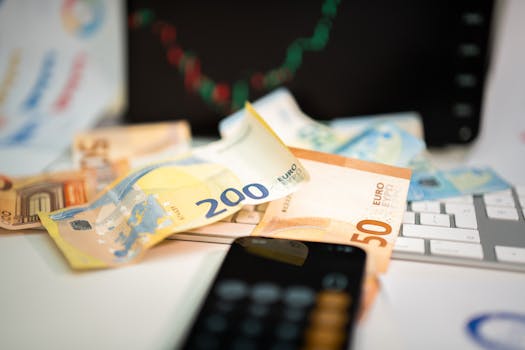Investing basics
The Difference Between Active and Passive Investing: Making Smarter Choices
Curious about active vs passive investing? Learn how each approach impacts your portfolio, fees, and results. See clear examples to choose what fits your goals and daily routine best.
Advertisement
Picture someone checking stock prices at breakfast while their friend sips coffee, hands off the market. These approaches capture the core of active vs passive investing, a choice every aspiring investor will face sooner or later.
Deciding between these two styles shapes not just portfolio results, but also the amount of time, research, and effort you’ll put into managing your investments. Understanding the split can clarify your path, whether you’re starting, scaling, or optimizing.
Ready to decode the practical differences, pros, and cons? Follow along as we get specific about what active vs passive investing truly means for your goals, time, and mindset.
Spot Key Flashpoints: What Makes Active and Passive Approaches Distinct
This section helps you immediately recognize where active and passive investing part ways in the real world. See clear guidance for anyone weighing which fits their goals, day-to-day routine, or personality best.
Active vs passive investing can feel technical, but the distinction shows up clearly in daily decisions. These aren’t just academic styles—they’re mindsets that play out in investor behavior and results alike.
Assessing Your Own Time Commitment
Some investors log in daily, scanning news and charts before placing trades. Others check their portfolios quarterly or even yearly. This active vs passive investing split reflects time willingness as much as performance ambition.
If you thrive on research, enjoy spirited debates on stock picks, or like keeping score with benchmarks, active investing’s hands-on pace can feel rewarding. Still, it demands discipline and vigilance each day.
Passive investing asks for initial groundwork—choosing index funds or ETFs, then holding on. After this, you simply monitor and rebalance at defined intervals, freeing hours for other pursuits.
Analyzing the Costs: Fees and Expenses Side by Side
Trading stocks, researching companies, and moving in and out of positions each carry explicit costs. Active investors pay for the privilege of agility and high-touch management. This isn’t just about commissions; mutual funds with active management layer on higher annual fees too.
In the world of passive investing, fees are kept low. Index funds or ETFs generally require less human oversight, so lower expense ratios translate to better long-term net returns, according to extensive research.
If you’re naturally cost-conscious or investing for decades, passive investing’s frugal structure often delivers more of your gains back into your own pocket over time.
| Criterion | Active Investing | Passive Investing | Takeaway |
|---|---|---|---|
| Time Needed | Daily or weekly attention | Minimal ongoing effort | Pick active for hands-on, passive for simplicity |
| Typical Fees | High (1%+ annually, plus commissions) | Low (0.05–0.3% typically) | Fee-conscious investors lean passive |
| Performance Goal | Aim to beat the market | Match broad market returns | Decide if you want to outperform or track indexes |
| Tax Efficiency | Lower—frequent trades create more taxes | Higher—buy/hold limits taxes | Passive means fewer taxable events |
| Research Required | Extensive, ongoing | Upfront, limited ongoing | Passive frees up mental and calendar space |
Create a Fit: Matching Strategies with Realistic Lifestyle and Goals
This section makes it easy to align active vs passive investing with real-world responsibilities and ambitions. Whether your diary’s packed or wide open, choosing the right method can help keep you disciplined and confident.
Understanding your temperament predicts your perseverance. People who grow bored by daily markets may falter with active investing. Others, energized by control and news cycles, may find passive investing too hands-off.
Aligning with Busy Schedules
If you’re raising kids, juggling career deadlines, or traveling, passive investing’s low-touch nature can encourage consistent saving without constant oversight. Automatic investments and periodic rebalancing fit nearly any schedule.
Active investing, by contrast, amplifies stress if missed opportunities loom large. FOMO can set in when the market whipsaws or friends boast big, fast wins. This style usually suits those able to carve out daily research blocks.
- Automate portfolio contributions on payday—guarantees investing while managing cash flow in the background.
- Schedule portfolio reviews at fixed intervals—prevents emotional, market-timed reactions, supporting a long-term plan.
- Use index funds or ETFs—minimizes management needs, fitting neatly into busy or fluctuating routines.
- Rebalance quarterly or yearly—ensures intended allocation without needing to watch markets daily or weekly.
- Favor low-fee investments—keeps more returns without ongoing decisions, reducing regret and mental accounting.
Passive investing matches well with people whose energy is spread among family, work, or creative pursuits, letting the market’s broad growth do the heavy lifting.
Channeling the Urge to Outperform
If you often think, “I’d like to do better than average,” active investing may appeal to your mindset. This camp analyzes earnings, news, and trends before acting, relishing the challenge to predict and adapt.
Growth-seekers might buy specialized mutual funds, research individual companies, or play sector rotations. Still, even active fans should set rules (“sell if shares drop 10%,” etc.) to guard against knee-jerk decisions.
- Set stop-loss orders to cap downside—protects from overcommitment to declining stocks, keeping losses manageable.
- Track your returns monthly or quarterly—provides accountability and allows for timely adjustments, avoiding drift.
- Read company reports and earnings calls weekly—stays ahead of news that affects active positions.
- Evaluate new ideas against broad-market index—serves as a reality check before changing strategy.
- Analyze after-tax returns—net results matter more than headline figures when paying frequent capital gains taxes.
Active investing rewards those with discipline and curiosity, though it takes humility to recognize when the effort isn’t paying off relative to the market average.
Spotting Performance Patterns: Measuring Results Over the Long Haul
This section enables readers to interpret performance stories with a critical eye. The data on active vs passive investing highlights persistent patterns unseen at a glance.
Letting Data Tell the Story
SPIVA Scorecards, published by S&P, track outcomes by active managers versus passive benchmarks. Year after year, the majority of active managers underperform broad indexes after fees are considered. This finding repeats globally and across asset classes.
Active vs passive investing debates benefit when investors rely on empirical evidence. If your strategy consistently lags the S&P 500, a behavioral shift may warrant consideration or at least a deeper review.
Use rolling returns or relative benchmarks, not just point-in-time wins, when judging your style’s success. Performance judged over five- to ten-year windows tells a more truthful story than short-term wins or losses.
Managing the Emotional Cycle
Behavioral research shows that chasing hot funds or stocks—and bailing during slumps—can erode returns, regardless of style. Active investors feel this stress more sharply, as decision points and FOMO compound with market volatility.
Passive investing’s routine (buy, rebalance, repeat) removes many emotion-driven pitfalls. Investors report less stress and second-guessing. The repetition becomes almost meditative, lowering the risk of panic selling.
Self-conscious moments happen; seasoned passive investors typically remind themselves, “I’m building wealth for decades, not days,” before reacting to bad news or market dips.
Balancing Flexibility and Consistency for Results You Can Stick With
This section gives step-by-step strategies for blending or switching styles as life changes, based on the real experience of active vs passive investing.
Combining Methods for a Custom Fit
Investors who blend approaches commonly hold the majority in passive index funds, but allocate 10–20% for active ideas or sector punts. This “core-satellite” mix lets you scratch the itch without putting the whole portfolio at risk.
Here’s a sample blend: 80% S&P 500 ETF for reliability, 20% in individual stocks or actively managed funds. Adjust as you learn your tolerance for outperformance and swings.
Setting a cap (“I’ll only make five active trades per year”) can help keep you from overtrading, which eats into performance through fees and taxes.
Pivoting Styles During Life Transitions
Life events prompt style changes too. Someone retiring may convert a formerly active portfolio into index funds seeking stability, while a new windfall can allow for a bigger “fun money” active slice.
Conversely, major time constraints—like a new job, child, or relocation—favor narrowing focus to a simplified, passive approach temporarily.
It’s routine for people to revisit preferences each year. Many say, “After reviewing my returns, I’m moving more toward passive for peace of mind.”
Final Take: Charting a Smart Investing Style for Your Goals
Both active vs passive investing methods offer unique strengths—and knowing what fits today makes your journey easier. Every approach rewards thoughtful planning, patience, and clear rules you’re willing and able to follow.
Each style can succeed for different lifestyles, time commitments, and risk tolerances. The active vs passive investing debate isn’t about right or wrong, but about clarity, honesty, and fit as your money works for you.
Choose a structure you can genuinely maintain through market ups and downs. Your investing style, like your personal habits, should help you make steady progress, not add stress or confusion to your financial life.





